第十公司治理(纽约大学艾伦和盖尔金融经济学讲义)
第10章公司治理

三、内部治理结构
(一)什么是内部治理结构 公司内部形成的一套有效激励且约束经理的制度安 通过自身的制度安排, 排,通过自身的制度安排,保证企业健康发展 ——目的 目的 实现对经理人的激励 实现对经理人的约束 实现对经理人的监督 (二)内部治理结构通过以下形式实现 ——所有权集中 所有权集中 ——董事会 董事会 ——管理者报酬 管理者报酬
方法一: 方法一: 建立监督机制
方法二: 方法二: 建立激励机制
二、两权分离和代理问题
3. 股东与管理者(经理)之间的代理问题 股东与管理者(经理) (2)建立激励机制的具体方式 建立激励机制的具体方式 ——将管理者的奖金与其管理绩效联系在一起 将管理者的奖金与其管理绩效联系在一起。 ——将管理者的奖金与其管理绩效联系在一起。 具体方式如下: 具体方式如下:
二、两权分离和代理问题
股东与管理者(经理) 3. 股东与管理者(经理)之间的代理问题 (1)防止管理者背离股东目标的具体措施 ——通常可以采用以下两种方法 通常可以采用以下两种方法: ——通常可以采用以下两种方法:
通过考评等监督方式, 通过考评等监督方式, 促使管理者不违背股东的 利益目标, 利益目标,否则管理者将 面临降低工资甚至解聘的 威胁;外部监督: 威胁;外部监督:独立董 事或经理人市场等
三、内部治理结构
2、董事会 如何提高董事会的有效性 增加董事会成员背景的多样性; (1)增加董事会成员背景的多样性; 内部管理和财务控制系统的加强; (2)内部管理和财务控制系统的加强; 建立并持续正式的董事会表现评估流程; (3)建立并持续正式的董事会表现评估流程; 设立“领导董事”职位; (4)设立“领导董事”职位; (5)董事报酬的修改; 董事报酬的修改; (6)适度增加独立董事持有的所有权
公司金融课程讲义第10章
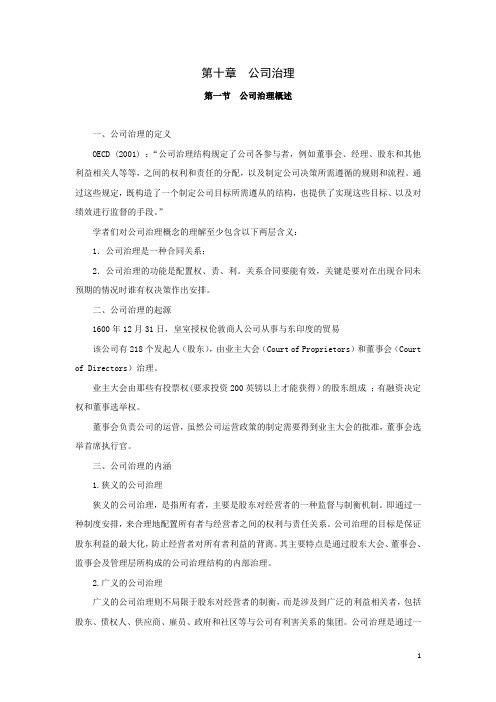
第十章公司治理第一节公司治理概述一、公司治理的定义OECD (2001) :“公司治理结构规定了公司各参与者,例如董事会、经理、股东和其他利益相关人等等,之间的权利和责任的分配,以及制定公司决策所需遵循的规则和流程。
通过这些规定,既构造了一个制定公司目标所需遵从的结构,也提供了实现这些目标、以及对绩效进行监督的手段。
”学者们对公司治理概念的理解至少包含以下两层含义:1.公司治理是一种合同关系;2.公司治理的功能是配置权、责、利。
关系合同要能有效,关键是要对在出现合同未预期的情况时谁有权决策作出安排。
二、公司治理的起源1600年12月31日,皇室授权伦敦商人公司从事与东印度的贸易该公司有218个发起人(股东),由业主大会(Court of Proprietors)和董事会(Court of Directors)治理。
业主大会由那些有投票权(要求投资200英镑以上才能获得)的股东组成;有融资决定权和董事选举权。
董事会负责公司的运营,虽然公司运营政策的制定需要得到业主大会的批准,董事会选举首席执行官。
三、公司治理的内涵1.狭义的公司治理狭义的公司治理,是指所有者,主要是股东对经营者的一种监督与制衡机制。
即通过一种制度安排,来合理地配置所有者与经营者之间的权利与责任关系。
公司治理的目标是保证股东利益的最大化,防止经营者对所有者利益的背离。
其主要特点是通过股东大会、董事会、监事会及管理层所构成的公司治理结构的内部治理。
2.广义的公司治理广义的公司治理则不局限于股东对经营者的制衡,而是涉及到广泛的利益相关者,包括股东、债权人、供应商、雇员、政府和社区等与公司有利害关系的集团。
公司治理是通过一套包括正式或非正式的、内部的或外部的制度或机制来协调公司与所有利害相关者之间的利益关系,以保证公司决策的科学化,从而最终维护公司各方面的利益图10-1:公司治理的层次和环境四、公司治理的主体和客体1.公司治理的主体公司治理的主体不仅局限于股东,而是包括股东、债权人、雇员、顾客、供应商、政府、社区等在内的广大公司利害相关者。
公司治理学第1-6章
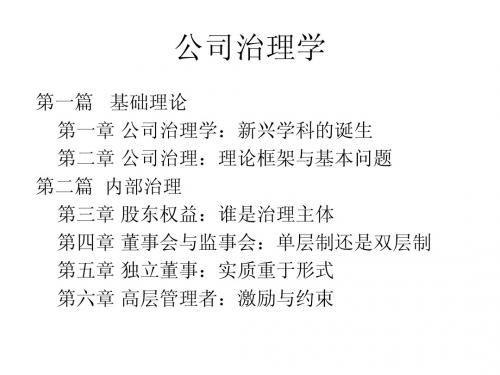
第二节 独立Biblioteka 事的独立性一、“独立性”的不同层次 (一)一般独立性与特殊独立性 (二)名义独立性与事实独立性 二、不同治理模式下独立董事的“独立性” (一)英美模式 (二)德日模式 (三)东南亚模式 三、不同国家公司法对“独立性”的界定 (一)英国公司法 (二)特拉华州公司法 (三)密歇根州公司法 (四)中国公司法
补充内容
公司的起源? 1、春秋战国时期 2、古罗马 公司的雏形? 1、中世纪 2、1606年的荷兰阿姆斯特丹——荷兰东印度公司 现代公司的成型? 1、1841年美国西部铁路公司 美国西部铁路公司
• 最早的萌芽产生于山东淄博临淄,有《史记》记 载为证:“管仲曰:吾始困时,尝与鲍叔贾,分 财利多自与,鲍叔不以我为贪,知我贫也。吾尝 为鲍叔谋事而更穷困,鲍叔不以我为愚,知时有 利不利也。吾尝三仕三见逐于君,鲍叔不以我为 不肖,知我不遭时也。吾尝三战三走,鲍叔不以 我为怯,知我有老母也。公子纠败,召忽死之, 吾幽囚受辱,鲍叔不以我为无耻,知我不羞小节 而耻功名不显于天下也。生我者父母,知我者鲍 子也。”
第二节 董事会的模式与运行
一、董事会模式的分类 二、双层董事会的特征 三、单层董事会中的次级委员会 四、董事会的运行 (一)会议准备 (二)所需信息 (三)制定决策 (四)会议机制 (五)会议备忘录与集体责任
第三节 监事会的设置与运行
一、监事会设置的国别差异 (一)公司内部不设监事会,相应的监督职能有独 立董事发挥 (二)设立监事会,且监事会的权利在董事会之上 (三)设立监事会,但监事会与董事会是平行机构, 也叫复合结构 二、我国监事会的相关规定 (一)我国《公司法》所表述的监事会 (二)《国有企业监事会暂行条例》所表述的监事 会 (三)监事会或者监事所行使的职权
《公司治理理论》笔记

3
账面价值股票
用股票的账面价值衡量业绩,避免证券市场的反复无常 等缺点
4 业绩股份
公司用普通股作为长期激励性报酬支付给高管,前提是 完成了事先规定的业绩指标(通常用EPS的增量作为标 准)
5
股票无条件授予
一般只有在公司受重大事件影响、处于关键性的转型时 期或是在刚刚成立、正处于艰难创业期的情况下使用
8
解决代理问题的公司治理机制
把经理报酬与股 东利益挂钩
设立董事会监督 管理层
在股东大会上行 使表决权
并购和接管,改
组董事会和管理 层
社会舆论及机构 规制
9
目录
章节 导言 第一章 代理型公司治理问题 第二章 剥夺型公司治理问题 第三章 经理的激励性报酬 第四章 内部人持股 第五章 董事会制度 第六章 股东权利及其保护 第七章 资本市场与公司控制 第八章 利益相关者与公司治理 第九章 公司治理的基础设施 第十章 公司治理的历史演进
页码 3 6 11 15 20 22 25 27 29 32 34
26
并购防御
毒丸 ➢ 指公司股东或董事会可以授权进行某种形式的定向发行 ➢ 毒丸计划被执行的前提是发生了事先约定的某种事件
金保护伞
➢ 按照控制权变动条款, 在公司被接管以后, 对市区工作的管理人 员进行报酬及其他收 益的补偿
并购防御的 四种形式
400 400 0 20 20 0
1000 500 500 200 100 100
2000 500 1500 1000 250 750
3000 500 2500 600 100 500
4000 500 3500 200 25 175
19
员工持股方案
通常在上市公司中,员工持股数量不超过公司总发行股份的20% 内部人持股是否有利于公司业绩,目前学术界还有争论
公司治理第1章

第二节 公司治理的内涵
二、公司治理的内涵
是一种契约性制度安排; 涉及到股东、董事会、经理层和其他利益相关者; 核心是合理配置公司控制权和剩余索取权; 是协调公司有关利益各方的一整套内部权力分配和制衡机制。
第一章 公司治理概述
❖第三节 公司治理的主客体
第三节 公司治理的主客体
一、公司治理主体的选择——谁参与公司的治理?
股东利益至上理论
股东利益至上理论的基本理念是管理者服务于股东, 股东是公司剩余风险的承担者,股东拥有使用、处置、 转让其产权的权力,管理者的目标就是追求股东利益 最大化。
第三节 公司治理的主客体
股东利益至上理论的局限性
企业价值增值的来源不仅仅是股东最初投入的物质资 本要素
人力资本是企业价值增值的重要资源,企业职工也与 股东一样承担了与企业经营效益相关的风险
课程内容设置?第一部分公司治理概述?第一章公司治理概述?第二部分内部治理?第二章股东大会董事会与监事会?第三章独立董事?第四章高层管理者?第三部分外部治理?第三部分外部治理?第五章证券市场与控制权配置?第六章银行治理?第七章机构投资者治理?第四部分公司治理评价?第八章公司治理原则与评价?第五部分专题?专题一审计委员会?专题二薪酬委员会第一章公司治理概述?第一节公司治理问题的产生?第二节公司治理的内涵?第三节公司治理的主客体?第四节公司治理研究的主题?第五节公司治理的基本框架第一章公司治理概述?第一节公司治理问题的产生第一节公司治理问题的产生第一节公司治理问题的产生一什么是企业
▪ 经理人员只是董事会一定权限的代理人。其权限受董事会委托范 围的限制,超过其权限的决策要报告董事会审定。
▪ 董事会对经理人员是有偿雇用。董事会有权对其经营情况进行监 督,并据此对其做出奖惩决定。
教学课件第10章公司治理专题
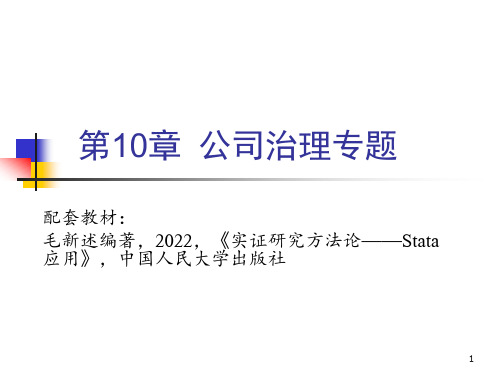
由于管理层权力的存在,董事会受管理层俘获或影响 ,从而使最优报酬合同不但没有解决代理问题,反而 本身就成为一种代理问题
7
国有企业的公司治理
1.股东方面
股东的特殊性 股权结构的特殊性
2.董事会
不是所有的国有企业都有董事会 董事会组成的特殊性
3.经理层
限薪令
4.党的领导
会计师$") | regexm(d0201b`i',"^首席财务官$") | regexm(d0201b`i',"^财务负责人$") } codebook cfo_date split cfo_date,p(+) gsort dm nd -cfo_date2 //按任职日期倒序排序 by dm nd :keep if _n==1 //保留前任 drop n n1 n2 n3 n4 d0201b? d0701b? cfo_date? duplicates list dm nd //得到公司-年度的唯一识别
replace d0201b=subinstr(d0201b,",",",",.) //将中文,取代成英文, *检查是否存在分号、顿号 count if regexm(d0201b,";")
count if regexm(d0201b,";")
replace d0201b=subinstr(d0201b,";",",",.) //将中文;取代成英文,
forvalue i=1/4 { gen n`i'=d0201b`i'+"+"+d0701b`i' } //生成“职务+任职日期”的变量 gen cfo_date="" forvalue i=1/4{ replace cfo_date=n`i' if regexm(d0201b`i',"^财务总监$") | regexm(d0201b`i',"^总
公司治理培训课件
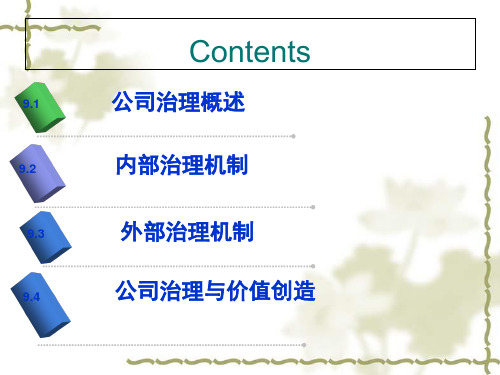
❖ 公司治理机制包括公司的内部治理和外部治理两部分。
内部控制系统(Internal Control System)指的是 在一个企业的资源计划范围内,可以用来实现企业的公 司治理目标的各种公司治理机制的总称。它包括股份、 股东、股东会与股权结构、董事会和管理层激励等方面。
外部控制系统(External Control System)是指公 司的出资者(股东和债权人)通过市场体系对经营者进 行控制,以确保出资者收益的方式。公司的外部治理机 制是通过市场的外部制约而发生作用的,涉及的内容较 多,主要包括控制权市场、债权人治理、产品和要素市 场等方面。
❖ 9.1.2 公司治理模式
❖ ⑴外部控制主导型模式
❖ 外部控制主导型模式又称市场导向型公司治理,外部 市场在公司治理中起着主要作用。该模式的前提是存在 一个流动性非常强的资本市场, 而且广泛分散的股权 结构和活跃的公司控制权市场。实行该模式的典型国家 主要是美国和英国。
该模式的基本特点是通过资本市场或其他市场的有效 运行来制约经理人的行为。具体表现在:首先,一般股 东与公司的关系比较淡化;其次,是公司不设监事会, 由董事会履行监督职责;第三,激励经理人员的主要手 段是股票期权制度。
外部控制主导型模式有利于形成对对经理人的有力鞭 策和监督,促使董事会和经理把利润最大化作为公司的 主要奋斗目标。缺陷在于经营者迫于股东分红的强大压 力,只能偏重于追求短期盈利,从而导致公司经营行为 的短期化。
❖ ⑵内部控制主导型
内部控制主导型模式又成为网络导向型模式,是指 股东(法人股东)、银行(一般也是股东)和内部经 理人员的流动在公司治理中起着主要作用。通常资本 流通性相对较弱,证券市场不够活跃。该模式的典型 代表是德国和日本。
❖ 法国兴业银行危机
《公司治理概论》PPT课件

精选PPT
15
第二节 公司制企业的治理体系
内部治理
内部治理是基于委托-代理和产权理论,对 代理人实施激励,从而在公司的各个利益 主题之间进行剩余控制权与剩余索取权有 效配置的一套产权制度安排
精选PPT
16
第二节 公司制企业的治理体系 内部治理的基本原则和组织设计
由于契约的不完全性和信息不对称所引起 的不确定性,使得在公司内委托人与受托 人之间的权利与义务关系不能完全通过契 约解决。现代的公司内部治理主要通过激 励机制、监督机制与决策机制促使代理人 努力为实现委托人的目标努力。
现代企业制度
• 现代企业制度,是指能在高层次水平上适应现代 化社会化生产和市场经济要求的产权关系明确、 治理结构严谨、责权关系对等、筹资渠道广泛、 制约机制健全、企业规模可以迅速扩大并能稳定 持久地经营的股份有限公司企业制度。有限责任 公司,包括多主体(自然人或法人)的有限责任 公司和国有独资的有限责任公司则不充分具有或 不同时具有上述股份有限公司的这些特点。
• 研究发现,有员工参与决策的企业的生产效率高于没有进 行类似组织结构改变的企业;另外一些研究还发现,利润 分享与员工的工作效率呈正比关系。事实表明员工持股计 划对公司业绩没有负面影响。
精选PPT
29
第三节 扩展中的公司治理框架 利益相关者共同治理
现代企业理论研究认为,企业本质上是多边契约 关系的总和。契约本身所内含的利益主体的平等 性和独立性要求公司的利益主体之间应该是平等 、独立的关系。这些相互关联的主体包括股东、 债权人、经营者、生产者和消费者等。企业的效 率只能建立在利益相关者平等的基础之上。
• 新古典经济学中,企业不过是一个专业化的生产单位(黑 匣子),在这个黑匣子里面实现劳动,资本,管理者才能 等要素的结合,各种资源获得各自的边际贡献报酬。由于 把企业的概念过于简化,在该理论下,我们无法讨论企业 之间组织形式的差异及效率差异。
第二MM定理(纽约大学艾伦和盖尔金融经济学讲义)
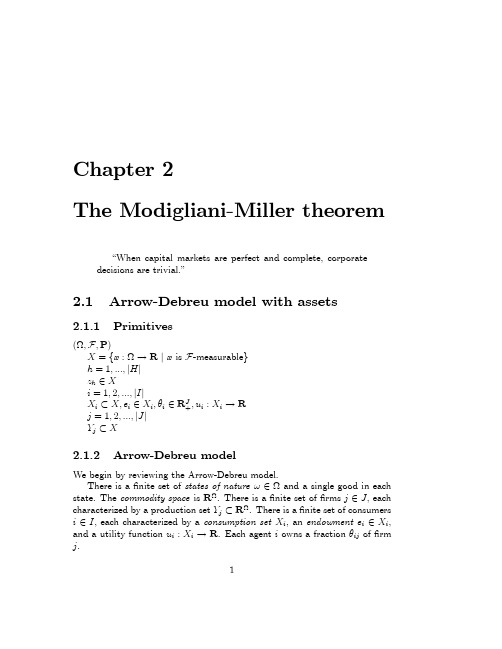
Chapter2The Modigliani-Miller theorem “When capital markets are perfect and complete,corporate decisions are trivial.”2.1Arrow-Debreu model with assets2.1.1Primitives(Ω,F,P)X={x:Ω→R|x is F-measurable}h=1,...,|H|z h∈Xi=1,2,...,|I|X i⊂X,e i∈X i,θi∈R J+,u i:X i→Rj=1,2,...,|J|Y j⊂X2.1.2Arrow-Debreu modelWe begin by reviewing the Arrow-Debreu model.There is afinite set of states of natureω∈Ωand a single good in each state.The commodity space is RΩ.There is afinite set offirms j∈J,each characterized by a production set Y j⊂RΩ.There is afinite set of consumers i∈I,each characterized by a consumption set X i,an endowment e i∈X i, and a utility function u i:X i→R.Each agent i owns a fractionθij offirm j.12CHAPTER2.THE MODIGLIANI-MILLER THEOREM An allocation is an array(x,y)=³{x i}i∈I,{y j}j∈J´such that x i∈X i for every i and y j∈Y j for every j.An allocation(x,y)is attainable ifX i x i=X i e i+X j y j.A price system or price vector is a non-zero element p∈RΩ.An Walrasian equilibrium consists of an attainable allocation(x,y)and a price system such that,for every j,y j∈arg max{p·y j:y j∈Y j},and for every i,x i∈arg max{u i(x i):x i∈X i,p·x i≤p·Ãe i+X jθij y j!.Note that unlike the standard model,we assume that consumers receive cashflows in each state directly.Note that shareholders unanimously want thefirm to adopt profit maxi-mization as its objective function.Under well known conditions,every competitive equilibrium is Pareto-efficient and every Pareto-efficient allocation is a competitive equilibrium with lump-sum transfers.2.1.3SecuritiesNow we introduce afinite set of securities h∈H each represented by a vector of returns z h∈RΩ.Securities are in zero net supply.The vector of securities prices is denoted by q∈R H where q h is the price of security h.Let(x,y,p)be a Walrasian equilibrium and suppose that consumers and firms are allowed to trade securities at the prices q.Letαj(resp.αi)denote firm j’s(resp.consumer i’s)portfolio excess demand for securities.Firm j’s profit is nowp·Ãy j+X hαjh z h!−q·αjand consumer i’s budget constraint is nowp·x i+q·αi≤p·Ãe i+X jθij y j+X hαih z h!.2.1.ARROW-DEBREU MODEL WITH ASSETS3Equilibrium requires thatq h=p·z h,∀h∈H.Otherwisefirms could increase profits without bound.But under this condi-tion,any portfolio is optimal.Thus equilibrium with securities requires only that attainability be satisfied:X iαi+X jαj=0.We can do the same thing with traded equity.If equity is fairly priced,there is no reason for anyone to trade it.2.1.4Irrelevance of capital structurea i=(x i,αi,βi)∈A i≡X i×R H×R Ja j=(y j,αj)∈A j≡Y j×R Ha=(a i)i∈I×(a j)j∈JDefinition1An allocation a=(a i)i∈I×(a j)j∈J is attainable ifX i∈I x i=X j∈J y jX i∈Iαi+X j∈Jαj=0X i∈Iαi=1.Definition2An attainable allocation a=(a i)i∈I×(a j)j∈J is weakly efficient if there does not exist an attainable allocation a0=(a0i)i∈I×(a0j)j∈J such that u i(x i)<u i(x i)for all i.An attainable allocation a=(a i)i∈I×(a j)j∈J is(strongly)efficient if there does not exist an attainable allocation a0= (a0i)i∈I×(a0j)j∈J such that u i(x i)≤u i(x i)for all i and u i(x i)<u i(x i)for some i.Definition3A Walrasian equilibrium consists of an attainable allocation a=(a i)i∈I×(a j)j∈J and a price vector(p,q)∈X×R H such that,for every j,a j∈A j maximizes the value of thefirmV j=v j−X h q hαjh=p·Ãy j+X hαjh z h!−X h q hαjh4CHAPTER2.THE MODIGLIANI-MILLER THEOREMand,for every i,a i∈A i maximizes u i(x i)subject to the budget constraint p·x i+X hαih q h+X jβij v j≤p·e i+X jθij V j+p·ÃX hαi z h+X jβijÃy j+X hαjh z h!!.Theorem4Let(a,p,q)∈X×R H∈A×X×R H be a Walrasian equilibrium and let(α0j)j∈J be an arbitrary allocation of portfolios forfirms.Then there exists a Walrasian equilibrium(a0,p,q)such thata0=(a0i)i∈I×(a0j)j∈Ja0i=(x i,α0i,β0i),∀ia0j=(y j,α0j),∀j.Note also that,by the previous argument,V j=V0j for every j.There are two aspects to the Modigliani-Miller theorem:one says that thefirm’s choice offinancial strategyαj has no effect on the value of the firm(or shareholder’s welfare);the other says that the choice ofαj has no essential impact on equilibrium.Here we are making the second(stronger) claim.2.2Equilibrium with incomplete marketsTo simplify,and avoid some thorny issues about the objective function of the firm,we assume that production sets are singletons:Y j={¯y j},∀j∈J.We start by assuming thatfirms do not trade in securitiesαj=0.There are no Arrow securities,so that consumption bundles can only be achieved by trading securities.x i=e i+X jθij y j+X hαij z h+X jβij y j.2.2.EQUILIBRIUM WITH INCOMPLETE MARKETS5 Sincefirms have no decision to make,equilibrium is achieved if consumers maximize their utility subject to the budget constraint:max u i(x i)s.t.P jβij v j+q·αi≤P jθij v j;and markets for shares and securities clear:X iαi=0and X iβi=(1,...,1).Now changeαj=0toˆαj,change v j toˆv j=v j+q·αj,and changeαi to ˆαi=αi−P jβijˆαj.Checking the optimality of the consumers problem and the attainability conditions we see that the economy is still in equilibrium. Definition5An equilibrium with incomplete markets consists of an attain-able allocation a=(a i)i∈I×(a j)j∈J∈A and a price vector(q,v)∈R H×R J such that,for every j,a j∈A j maximizes the value of thefirmV j=v j−X h q hαjh=max i(µi·Ãy j+X hαjh z h!)−X h q hαjhand,for every i,a i∈A i maximizes u i(x i)subject to the budget constraintX hαih q h+X jβij v j≤X jθij V j,wherex i=e i+X hαih z h+X jβijÃy j+X hαjh z h!.Theorem6Let(a,q,v)∈A×R H×R J be an equilibrium with incomplete markets and let(α0j)j∈J be an arbitrary allocation of portfolios forfirms.Then there exists an equilibrium with incomplete markets(a0,q,v0)such thata0=(a0i)i∈I×(a0j)j∈Ja0i=(x i,α0i,β0i),∀ia0j=(y j,α0j),∀j.6CHAPTER2.THE MODIGLIANI-MILLER THEOREM Note that the space of commodity bundles that can be spanned by trading equity and securities is exogenous,but only because we have assumed the firm’s choice of production plan is exogenous.In other words,there is no financial innovation.This assumption is crucial for the MM theorem.2.3Default2.3.1Default with complete marketsFor simplicity we assume there is a singlefirm j=1with a single feasible production plan y(ω)>0,and a single security with payoffs z(ω)=1. Limited liability raises the possibility of default and risky debt.Letˆz(αj,ω) denote the return to risky debt andˆy(αj,ω)the return to equity in afirm with risky debt.Thenˆz(αj,ω)=½z(ω)if y(ω)+αj z(ω)≥0y(ω)/(−αj2)if y(ω)+αj z(ω)<0.andˆy(αj,ω)=½y(ω)+αj z(ω)if y(ω)+αj z(ω)≥00if y(ω)+αj z(ω)<0.If there are complete markets,the value of the risky debt isˆq=p·ˆz(αj)and the value of equity isˆv=p·ˆy(αj).The value of thefirm to the original shareholders isˆV=ˆv+ˆqαj=p·ˆy(αj)+αj p·ˆz(αj)=p·y.So default doesn’t add value to thefirm.Assume that there is a single type offirm j consisting of a continuum of identicalfirms.Thesefirms choose different levels of risky debt.The number of securities may be great enough to span the entire commodity space RΩ. For example,suppose y(ω)=ωand chooseαωj=−ω+1forω=1,...,|Ω|.2.3.DEF AULT7Thenˆy³α|Ω|j´pays one unit ifω=|Ω|and nothing otherwise,that is,it is an Arrow security for the stateω=|Ω|.A portfolio consisting of one unit ofˆy³α|Ω|−1j´and minus two units ofˆy³α|Ω|j´will yield one unit in state ω=|Ω|−1and nothing otherwise,that is,it is an Arrow security for the stateω=|Ω|−1.Continuing in this way we can generate Arrow securities for each state.This is a case where capital structure is irrelevant for the individualfirm,but not for the equilibrium.2.3.2Default with incomplete marketsTo define an equilibrium,we assume that consumers can hold thefirm’s debt but cannot issue debt or sell short thefirm’s equity.(This isn’t necessary, but simplifies the story).Definition7An equilibrium with incomplete markets and default consists of an attainable allocation a=(a i)i∈I×(a j)∈A and a price vector(q,v)∈R H×R such that a j∈A j maximizes the value of thefirmV j=v j−qαj=max i{µi·(y j(αj)+αjˆz(αj))}−qαj and,for every i,a i∈A i maximizes u i(x i)subject to the budget constraintαi q+βi v≤θi V,wherex i=e i+αiˆz(αj)+βi(y j(αj)+αjˆz(αj)).In this case,we have to deal with the valuation problem explicitly:be-cause markets are incomplete,individuals may disagree in their valuation of a security.Only those who value it most highly will hold a positive quantity of a security or equity in equilibrium.2.3.3Related issuesWith complete markets,all shareholders agree that value maximization is the right objective function for thefirm.With incomplete markets,this may not be the case.Thefirm’s choice of y j andαj has two effects,on the value of thefirm V j and on the risk sharing that can be achieved by8CHAPTER2.THE MODIGLIANI-MILLER THEOREM holding shares and risky debt.One solution to this problem:if thefirm’s cash stream can be spanned by otherfirms’cash streams,the contribution to risk sharing is redundant and only the value of thefirm matters.See Bell Journal Symposium(Ekern and Wilson(1974),Leland(1974),Radner (1974)).Another solution:if there is a large number of identicalfirms,each type of consumer can hold shares in a version of thefirm that uniquely optimizes his needs for risk sharing.See Hart(1979).When these are not available,for example,because the number offirms isfinite,the theory of thefirm becomes very difficult(see for example,Dreze(1974),Grossman and Hart(1979)).Perhaps for this reason,much fo the theory of general equilibrium with incomplete markets has been developed for pure exchange models.For the valuation problem in general,see Allen and Gale(1988)or the Allen and Gale(1994).For an analysis of the Modigliani-Miller Theorem with default in a partial equilibrium setting,see Stiglitz(1969)and Hellwig (1981).2.4BibliographyAllen,F.and D.Gale,(1988).“Optimal Security Design,”Review of Finan-cial Studies1,229-263.–(1992).“Arbitrage,Short Sales,and Financial Innovation”Economet-rica59,1041-68.–(1994).Financial Innovation and Risk Sharing.Cambridge,MA:MIT Press.Arrow,K.(1964).“The Role of Securities in the Optimal Allocation of Risk-Bearing,”Review of Economic Studies31,91-96.Arrow,K.and G.Debreu(1954).“Existence of equilibrium for a com-petitive economy,”Econometrica22,265-290.Dammon,R.and R.Green(1987).“Tax Arbitrage and the Existence of Equilibrium Prices for Financial Assets,”Journal of Finance42,1143-66.Duffie,J.D.and W.Shafer(1985).“Equilibrium in Incomplete Markets: I—A Basic Model of Generic Existence,”Journal of Mathematical Economics 14,285-300.–(1986).“Equilibrium in Incomplete Markets:II;Generic Existence in Stochastic Economies,”Journal of Mathematical Economics15,199-216.Dreze,J.(ed.)(1974).Allocation under Uncertainty:Equilibrium and Optimality;proceedings from a workshop sponsored by the International2.4.BIBLIOGRAPHY9 Economic Association.New York:Wiley.Ekern,Steinar and Robert Wilson(1974).“On the Theory of the Firm in an Economy with Incomplete Markets Bell Journal of Economics5,171-80.Grossman,S.and O.Hart(1979).“A Theory of Competitive Equilibrium in Stock Market Economies,”Economtrica47,293-329.Hart,O.(1975).“On the Optimality of Equilibrium when the Market Structure is Incomplete,”Journal of Economic Theory11,418-43.–(1979).“On Shareholder Unanimity in Large Stock Market Economies,”Econometrica47,1057-83.Hellwig,M.(1981)“Bankruptcy,Limited Liability,and the Modigliani-Miller Theorem,”American Economic Review71,155-70.Leland,H.(1974).“Production Theory and the Stock Market,”Bell Journal of Economics5,125-44.Magill,M.and M.Quinzii(1996).Theory of Incomplete Markets,Volume 1.Cambridge MA:MIT Press.Radner,R.(1972).“Existence of Equilibrium of Plans,Prices,and Price Expectations in a Sequence of Markets,”Econometrica40,289-303.–(1974).“A Note on Unanimity of Stockholders’Preferences among Alternative Production Plans:A Reformulation of the Ekern-Wilson Model”Bell Journal of Economics5,181-84.Stiglitz,J.(1969)“A Re-Examination of the Modigliani-Miller Theorem,”American Economic Review59,784-93.。
中西方公司治理理论培训(doc 11页)
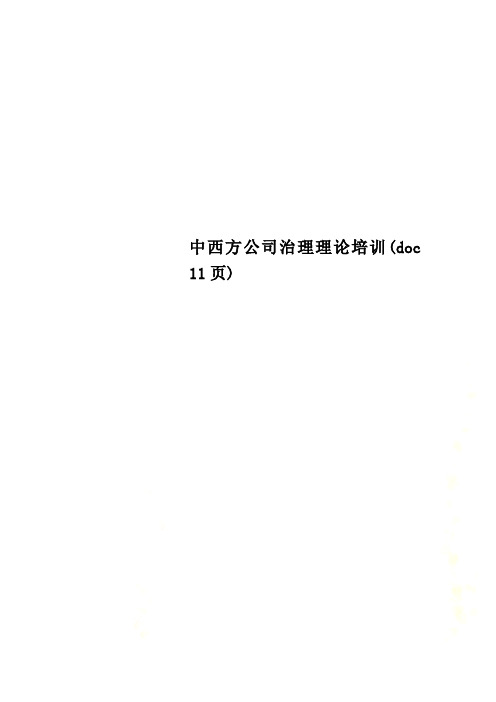
中西方公司治理理论培训(doc 11页)共中央关于国有企业改革和发展若干重大问题的决定》中明确说明:公司法人治理结构是公司制的核心。
要确股东会、董事会、监督会和经理层的职责,形成各司其职、协调运转,有效制衡的公司法人治理。
所有者企业拥有最终控制权。
董事会要维护出资人权益,对股东会负责,董事会对公司的发展目标和重大经营活动出决策,聘任经营者,并对经营者的业绩进行考核和评价。
发挥监事会对企业财务和董事、经营者行为的监作用。
(3)控制决策学说奥利弗·哈特在英国《经济学杂志》上发表文章认为:“治理结构被看作一个决策制,而这些决策在初始合约中没有明确地设定。
更确切地说,治理结构分配公司非人力资本的剩余控制权,资产使用权如果在初始合约中没有详细设定的话,治理结构将决定其将如何使用。
”中国经济学家张维迎在他的《企业理论与中国企业改革》一文中认为:有效的公司理结构在于剩余索取权与剩余控制权应当尽可能地对应,既拥有剩余索取权和承担风险的人应当拥有控制或者反之,拥有控制权风险的人承担风险。
公司治理结构有多种定义,多种内涵,前文从不同角度给出了治理结构的不同表吸取西方公司治理理论的成果,结合我国实践,概括起来说,公司治理结构是建立在出资者所有权与法人财权分离的基础上,企业内外部的股东会、董事会、监事会及经理层及其它利益相关者之间的权利制衡机制、励约束机制及市场机制的一种制度安排。
具体来说,公司治理结构既是一种经济关系、契约关系,又是一种利的制衡机制。
2西方两种治理模式分析:股东治理模式与利益相关者(或人力资本治理模式)理模式公司治理模式是用以处理不同利益集团即股东、债权人、管理人、员工和社区之间利益格局关系,实现一定经济目标的制度安排。
关于公司治理模式争论,在西方经久不衰,其核心就是“传的”、“股东治理模式”和“新兴的”、“利益相关者治理模式”或者目标利益优先的问题。
按照股东治理模式,作为股东代理人——总经理(或董事会),必须以股东价值最化作为企业经营的唯一目标和行为准则;而利益相关者理论认为,现代公司不仅归股东所有,其他利益相关实际上也为公司进行了投资(如员工进行了人力资本投资)。
公司治理培训教材(PPT 37页)
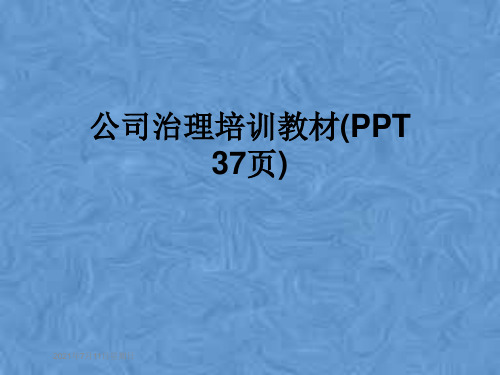
• 他们必须专注于他们的工作,必须为公司创造价值。
• 否则,一旦1 公司治理的概念
• 机构股东的兴起
• 股东进一步法人化和机构化的趋势使得英美等发达国家中股东高度分散化的情况 (社保基金)
• 2.双层结构 • 双层型治理结构之一(日本模式,我国现行公司法规定的模式与此类似)
• 双层型治理结构之二(德国模式)
中国石油天然气股份有限公司治理结构
36
•股 东 ( 大 ) 会 由 全 体 股 东 组 成 , 是 公 司 的 最 高 权 力 机 构 和 最 高 决 策 机 构 。
•公 司 内 设 机 构 由 董 事 会 、 监 事 会 和 总 经 理 组 成 , 分 别 履 行 公 司 战 略 决 策 职 能 、 纪 律 监 能
•董 事 会 是 股 东 ( 大 ) 会 闭 会 期 间 的 办 事 机 构 。
• 2.股东与公司治理
股东(管理人)
当股东自己经营管理公司
的时候不存在公司治理问
题
股 东
股东:委托人
收益
管理的专业化
经理人:代理人
和职业化
管理人
成本
代理成本:
委托代理问题
1、股东对管理人的监督成本;
2、代理人利用职务之便损害公司价值;
3、使用不称职代理人的机会成本。
• 3.股东的角色与定位 • 找出代理人,选聘董事,组成董事会; • 规定董事和管理层作为受托人的责任; • 保护股东自身的利益。
• 7.股东的义务 • 遵守公司章程; • 按期缴纳所认缴的出资; • 对公司债务负有责任; • 出资填补义务; • 追加出资义务; • 在公司核准后,不得擅自抽回出资; • 对公司及其他股东诚实信任; • 其他依法应当履行的义务。
公司治理教程
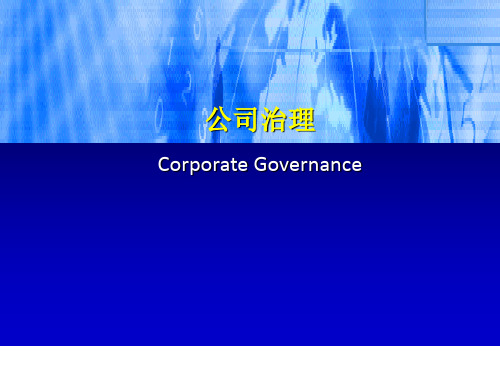
建立良好的公司治理机制的重要性
第三,有利于吸引长期稳定的国际资本。国际资本, 尤其是发达国家的资本在选择对外投资的地区、形式、 时间长短时,公司治理结构是首要考虑的问题之一。 对于公司治理机制薄弱的地区和公司,国际资本一般 选择进行以短期债务为主的投资,稍有冲击就撤资, 而对于具有良好公司治理机制的地区和公司,则倾向 于进行以股权为主的长期投资。因此,建立良好的公 司治理结构,可以增强企业吸引长期稳定的国际资本 的能力。为了适应国际资本的需求,美国的标准普尔 (Standard & Poor)公司建立了公司治理评级标准, 并已开始在俄罗斯试点。今后,随着公司治理评级的 普及,一个公司的公司治理等级会象其它的资信等级 那样,成为国际资本选择投资企业时主要考虑的因素 之一。
狭义的公司治理是指一组联结并规范公司股东、董事会、经 理人之间责、权、利关系的制度安排。
广义上,公司治理还包括公司与其他利益相关者 (Stakeholder,如员工、客户、供应商、债权人和社区等) 之间的关系,以及有关的法律、法规和上市规则等。
公司治理的概念
从内容上看,公司治理包括三个层次:公司内部治理机制、公司外部治理 市场、有关公司治理的法律法规。
公司治理
Corporate Governance
本章主要内容
公司治理的概念 公司内部治理机制 公司外部治理市场 有关公司治理的法律法规
公司治理理论兴起的背景与原因 机构投资者的兴起与股东参与意识的提高 公司的高管人员薪酬增长过快、引起股东和社会的普
遍不满 西方许多大公司在近20年的兼并重组过程中大量裁员,
公司治理理论兴起的背景与原因
现代股份有限公司的完全形态产生于19世纪,随着公司股权的日益分散及 所有权与经营权的分离,股东权力和股东大会逐渐空壳化与形式化,管理 层开始在公司中处于支配地位。Berle和Means最早对这一问题进行了系统 的分析和研究,并于1932年出版了《现代公司和私人产权》一书,对当时 占主导地位的股东主权思想提出了挑战。然而,在20世纪80年代以前,公 司治理问题并没有受到人们的注意和重视,其原因在于第二次世界大战之 后的30多年间,公司总体上来说运作的非常好,股东们大体上都得到了满 意的回报,员工的工资和福利也得到不断的提高,虽然各国法律都强调股 东主权主义,公司必须追求股东利益的最大化,但实践中许多公司并没有 忽视其社会责任。
公司治理-简体版
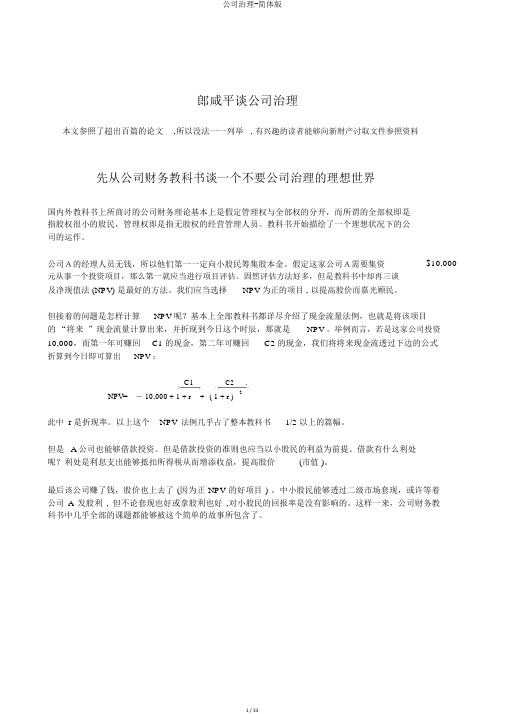
郎咸平谈公司治理本文参照了超出百篇的论文,所以没法一一列举, 有兴趣的读者能够向新财产讨取文件参照资料先从公司财务教科书谈一个不要公司治理的理想世界国内外教科书上所商讨的公司财务理论基本上是假定管理权与全部权的分开,而所谓的全部权即是指股权很小的股民,管理权即是指无股权的经营管理人员。
教科书开始描绘了一个理想状况下的公司的运作。
$10,000 公司A的经理人员无钱,所以他们第一一定向小股民筹集股本金。
假定这家公司A需要集资元从事一个投资项目,那么第一就应当进行项目评估。
固然评估方法好多,但是教科书中却再三谈及净现值法 (NPV) 是最好的方法。
我们应当选择NPV 为正的项目 , 以提高股价而嘉光顾民。
但接着的问题是怎样计算NPV 呢?基本上全部教科书都详尽介绍了现金流量法例,也就是将该项目的“将来”现金流量计算出来,并折现到今日这个时辰,那就是NPV 。
举例而言,若是这家公司投资10,000,而第一年可赚回C1 的现金,第二年可赚回C2 的现金,我们将将来现金流透过下边的公式折算到今日即可算出NPV :C1 C2 .NPV= - 10,000 + 1 + r + ( 1 + r ) 2此中r 是折现率。
以上这个NPV 法例几乎占了整本教科书1/2 以上的篇幅。
但是 A 公司也能够借款投资。
但是借款投资的准则也应当以小股民的利益为前提。
借款有什么利处呢?利处是利息支出能够抵扣所得税从而增添收益,提高股价(市值 )。
最后该公司赚了钱,股价也上去了 (因为正 NPV 的好项目 ) 。
中小股民能够透过二级市场套现,或许等着公司A 发股利, 但不论套现也好或拿股利也好,对小股民的回报率是没有影响的。
这样一来,公司财务教科书中几乎全部的课题都能够被这个简单的故事所包含了。
小股民为何需要公司治理呢但这个理想的公司运作模式在现实世界是不存在的,所以小股民就一定设计出一套系统以保证公司经理人员能追求小股民利益极大化。
公司治理教材

结构性制衡上来规范所有者(股东)与资产支配者(董事会), 资产管理者(经理)相互间的利益关系。
独立性要求
▪ 新的纽交所(NYSE)公司治理规则,“除非董事会能肯
定地确定董事与上市公司之间没有实质性的关系,否则
董事不满足独立性的要求。”NYSE还对前任雇员(直 接与间接,如互兼董事、家庭成员)规定五年的 “冷却期”。 ▪ NASDAQ公司治理,如董事的家庭成员是或三年内曾 是发行人或者其关联公司的高管,则不被认为是 独立的。对于前任雇员等规定三年的“冷却期”。 独立董事被禁止在董事会薪酬之外接受超过60,000 美元的支付。在非盈利机构中做高级管理人员的董 事也不认为是独立的。 ▪ 机构投资者也有其自己的一套准则。
对董事会的授权条款;为什么股东大会人数少? ▪ 决策机制与代理成本——内部人控制
▪ 董事会运作不规范:产生问题、组成问题、职权行使问 题、激励与约束机制问题
▪ 董事与经理的兼任
▪ 董事专业化程度 ▪ 投资决策透明度等等。
第16页,共45页。
三分开
▪ 证监会1998年《关于拟发行上市企业改制 情况进行调查的通知》中 “三分开”具体 是指:(1)人员独立;(2)资产完整;(3)财 产独立。2002年《上市公司治理准则》中 特别设立了一章——“控股股东与上市公 司”,将原本规范上市公司与控股股东行 为的“三分开”增加了新的内容。《公司 法》进一步强调。
第11页,共45页。
公司治理的一般模式
公司治理 的一般规则
公司治理导言

Ⅰ
Contents 目 录
第一章 导 论
第二章 企业制度的演进与公司治理理论发展 第三章 公司与公司法 第四章 股东权利与股东会制度 第五章 董事与董事会制度
第一章 导 论
1.1 公司治理问题的产生 1.1.1 股权结构分散化 1.1.2 所有权和控制权分离
第一章 导论 1.2.1 国外对公司治理的定义 知识结构图
第一章 导 论
2.经济学对公司治理的定义 • 吴敬琏(1994)认为公司治理结构是指由所有者、董事会和 高级执行人员即高级经理人三者组成的一种组织结构。要完 善公司治理结构,就要明确划分股东、董事会、经理人各自 权力、责任和利益,从而形成三者之间的关系。
• 斯坦福大学钱颖一教授在他的论文《中国的公司治理结构改 革和融资改革》中提出,“公司治理结构是一套制度安排, 用来支配若干在企业中有重大利害关系的团体,包括投资者、 经理、工人之间的关系,并从这种聪明中实现各自的经济利 益。公司治理结构应包括:如何配置和行使控制权;如何监 督和评价董事会、经理人和职工;如何设计和实施激励机 制”。
第一章 导 论
1.1.1 股权结构分散化
在公司制企业发展初期,公司规模相对较小,公司股东的数量也不多, 公司的股权结构相对集中。后来,由于现代企业制度的不断加速发展和公司 经营范围、规模的不断扩大,公司需要通过发行股票和债券来筹措大量的资 金,这样公司的持股人将会从原来的少数人变为多数人,他们可能是社会中 的个人,甚至是企事业单位、政府部门等组织机构,公司的股权结构逐步分 散化、多元化。 因此,股权结构的分散化是现代公司的第一个特征。 公司的股权结构,经历了由少数人持股到社会公众持股再到机构投资者 持股的历史演进过程。
根据对公司治理的定义可以得出公司治理是通过一整套包括正式或非正式 的制度或机制来协调公司董事会、股东与经理层等之间的利益关系,以保证公 司决策的科学化,从而最终维护公司各方面的利益的一种制度安排。其内部制 度或机制是指由股东大会、董事会、监事会和经理层构成的内部权力机构的权 力分配及其相互制衡机制。这也是从微观层面来考虑和研究公司治理的。 除了从上述公司内部和外部制度或机制两个角度来研究公司治理外,还可 以从其他的角度来研究公司治理。公司治理受到传统文化和政治法律等因素的 影响,在不同的经济体制之下有着不同的模式。所有的公司治理制度或机制最 终还是要符合当地的文化传统、所在国家的相关法律,适应当地环境,一味的 模仿和照搬都不可能起到真正的效果。 正是基于上述考虑,我们才说公司治理学是一门探索公司治理实践中具有 共性的基本原理、运作规范和方法的科学。
世界各国公司治理原则列表

蓝带委员会
1999
英国
公司治理手册
英国养老金协会
1999
英国
PIRC股东投票准则
养老金投资研究顾问PIRC
英联邦
英联邦最佳企业做法原则
英联邦公司治理协会
Kyrgyz共和国
开放型公司股东协会样本章程
Kyrgyz共和国经济部门开发部总理办公室
Kyrgyz共和国
最佳做法手册&0;Kyrgyz共和国公司治理
1978,1994年修订
美国
公司治理的声明和美国的竞争力
商业圆桌会议BRT
1990
美国
公司治理原则:分析与建议
美国法律机构ALI
1992
美国
NACD蓝带委员会关于CEO和董事会绩效评估的报告
全美公司董事协会NACD
1994
美国
通用汽车公司董事会关于有意义的公司治理问题的治理准则
通用汽车公司董事会
,、和修订
制订时间
澳大利亚
投资管理者指南与公司做法建议的声明
澳大利亚投资管理者协会AIMA
,修订
澳大利亚
公司做法和准则Bosch报告
澳大利亚公司董事协会工作组、公共会计师协会、企业委员会、法律委员会、特许会计师协会和澳大利亚证券协会
1995年第三版
韩国
公司治理最佳做法准则
韩国公司治理委员会
马来西亚
马来西亚公司治理报告
俄罗斯联合体
关于保证股东权利办法的法令原为股东权利的声明
叶利钦总统
1996
法国
Lévy-Lang报告
CNPF-AFEP
1995
法国
VienotI报告
金融治理

金融业治理(Finance Industry Governance)是指经营金融商品的特殊行业的治理,包括顶层设计、金融 监管和金融机构治理三个层面内容。顶层设计(Top-Level Design)是指国务院关于金融业发展的重大问题做出 的安排和设计。金融监管(Finance Regulation)是指监管部门对监管对象做出的某种限制或规定。金融机构 治理(Finance Institution Governance)按照对象业务类型不同可以分为金融控股公司治理、银行治理、城 市信用合作社治理、农村信用合作社治理、保险公司治理、相互保险组织治理、证券公司治理、基金管理公司治 理、期货公司治理、信托公司治理、资产管理公司治理、财富管理公司治理、财务公司治理、贷款公司治理、货 币经纪公司治理、租赁公司治理、担保公司治理、汽车金融公司治理、消费金融公司治理、银行理财公司治理、 登记结算公司治理、股票证券所治理、黄金交易所治理、期货交易所治理、外汇交易中心治理等主体治理。
联合国全球治理委员会(Commission on Global Governance)在1995年对治理的概念进行了界定,认为 治理是指各种公共的或私人的个人和机构管理其共同事务的诸多方法的总和,是使相互冲突的或不同的利益得以 调和,并采取联合行动的持续过程。
- 1、下载文档前请自行甄别文档内容的完整性,平台不提供额外的编辑、内容补充、找答案等附加服务。
- 2、"仅部分预览"的文档,不可在线预览部分如存在完整性等问题,可反馈申请退款(可完整预览的文档不适用该条件!)。
- 3、如文档侵犯您的权益,请联系客服反馈,我们会尽快为您处理(人工客服工作时间:9:00-18:30)。
Chapter10Corporate Governance10.1The market for corporate controlThe agency problem that arises from the separation of ownership and control (Berle and Means,1932)has been a major focus of the literature on corporate finance and the theory of thefirm over the last twenty years.Various insti-tutional arrangements exist to deal with this agency problem and one that has attracted a lot of attention is the market for corporate control.Manne (1965)suggested that,if a publicly traded company is badly managed and the usual methods of corporate governance(board of directors,proxy bat-tles,etc.)are not effective in disciplining the management,a hostile takeover allows an outsider to acquire a controlling interest in thefirm,change the management,and realize an increase in shareholder value.Grossman and Hart(1980)provided a formal analysis of how the mar-ket for corporate control functions and pointed out the existence of a free-rider problem that may prevent takeovers from maximizing shareholder value. Here is a brief sketch of the model.The manager of afirm chooses an action a∈A and the resulting value of thefirm is denoted by V(a).Suppose the firm is under the control of an incumbent manager who for some reason(e.g., incompetence or private benefits)is not maximizing shareholder value.The optimal action is a∗but the manager chooses¯a.If a raider acquires control of thefirm and changes the action from¯a to a∗,social surplus increases by V(a∗)−V(¯a)and this gain in surplus can be shared between the raider andthe shareholders.A‘hold-out’problem arises because the existing shareholders anticipate12CHAPTER10.CORPORATE GOVERNANCE an increase in value if the raider successfully takes control of thefirm.The shareholders will be unwilling to tender their shares unless they are paid the full anticipated value.If takeovers are costly,the raider will undertake a takeover only if he anticipates a positive profit.But if the raider has to pay the full price he gets no profit from the takeover.To make this argument precise,consider the following game form:•The raider offers a price p for the shares of thefirm and pays afixed cost C>0(the cost of organizing the tender offer).•Each shareholder has a single share,which he can tender or retain.•If the raider acquires a fraction0<γ<1of the shares,he acquires control and can choose the action that maximizes the value of thefirm.If the fraction of shares tendered is less thanγ,the offer fails and the incumbent management is left in control.The equilibria of this game can be characterized by looking at these stages in reverse order.•At the last stage,if the raider has acquired a fraction g≥γof the shares,he gets control,chooses the optimal action a∗,and the value of thefirm is V(a∗).If he acquires a fraction g<γ,the incumbent manager remains in control,thefirm’s policy is unchanged,and the value of thefirm is V(¯a).•At the second stage,the shareholder receives the price p if he tenders his share.If he holds onto his share and the offer fails,his share is worth V(¯a).If he holds onto his share and the offer succeeds,his share is worth V(a∗).Thus,he will tender his share if p>V(¯a)(resp.p>V(a∗))and hold onto it if p<V(¯a)(resp.p<V(a∗)).•At thefirst stage,the raider must offer a price that equals the share-holders’reservation price to succeed.Thus,the offer can succeed only if p≥V(a∗).If the raider acquires a fraction g≥γof the shares,his profit is(p−V(a∗))g−C<0.10.1.THE MARKET FOR CORPORATE CONTROL3 So it appears that a takeover cannot succeed.Grossman and Hart suggest that dilution of the existing shareholders’property rights may provide the raider with sufficient profit to undertake the raid.Suppose that the dilution ratio isφ,that is,the raider can capture a fractionφof the minority shareholders’property rights by self-dealing,etc. Then the price offered must satisfy p≥(1−φ)V(a∗)and a successful tender offer is possible ifφV(a∗)≥C.Bagnoli and Lipman(1987)point out that the Grossman Hart model with a continuum of shareholders is special.Abstract:We noted at the outset that most of the literature ontakeovers assumes atomistic stockholders.As we pointed out,however,there are many largefirms for which this assumption isobviously inappropriate.This led us to consider thefinite stock-holder game.We showed that there are substantial differencesbetween thefinite game and the atomistic stockholder models.In particular,because some stockholders must be pivotal andhence cannot free ride,successful takeovers are possible withoutexclusion.Since the equilibrium outcome in thefinite stockholdergame is quite different from the atomistic stockholder outcome,the natural question to ask is under what conditions the atom-istic stockholder outcome obtains forfirms which are sufficientlywidely held.We showed that the atomistic stockholder outcomedoes not obtain in the infinite stockholder game.We also showedthat the difference between thefinite and atomistic stockholderoutcomes may not vanish in the limit.We argued that atom-istic stockholder models may provide a reasonable approximationto the outcome for takeovers with any-and-all bids if thefirm isnot sufficiently valuable relative to the dispersion of stock owner-ship.Otherwise,thefinite stockholder model is likely to providea more accurate prediction,so that exclusion is not necessary forsuccessful takeovers.Since,all else equal,stockholders generallybenefit more from takeovers without exclusion,our analysis sug-gests that stockholders would prefer to invest infirms which arevaluable relative to the dispersion of stock ownership.This,inturn,suggests that a givenfirm’s stock will not be“too”widely4CHAPTER10.CORPORATE GOVERNANCE held relative to its value.This seems like an interesting topic forfuture research.The essential idea is captured by the following game.Suppose there is a finite number of shareholders i=1,...,n and shareholder i holds a fraction θi of thefirm’s shares.The game is the same as above except that each shareholder i can tender a fraction t i≤θi of his shares and the raid succeeds if and only if X i t i≥γ.If the tender price is p the payoffto shareholder i isu i(p,t)=½(θi−t i)V(a∗)+t i p if P i t i≥γ(θi−t i)V(¯a)+t i p if P i t i<γ.Suppose that V(¯a)<p<V(a∗).Since we assume the offer succeeds if and only if P i t i≥γ,each shareholder will minimize his offer subject to this constraint.Any further reduction would cause the offer to fail and his payoffwould fall.For any p>V(¯a)it is optimal for agents to submit the maximumt i if the tender offer is expected to fail and the minimum consistent with P i t i≥γif it is expected to succeed.In a SPE the raider will offer p≤V(¯a) and the shareholders will choose to offer amounts t i such that P i t i≥γ.If p<V(¯a)there exists a trivial continuation equilibrium in which t i=0 for all i ifθi<γfor each i.The equilibrium constructed here depends crucially on the assumption that the fraction of the shares needed for control is known with certainty so that every shareholder is pivotal.Introducing a small amount of uncertainty could upset this equilibrium.Holmstrom and Nalebuff(1992)study mixed strategy equilibria of the finite game.Abstract:This paper reexamines Grossman and Hart’s(1980)in-sight into how the free-rider problem excludes an external raiderfrom capturing the increase in value it brings to afirm.Theinability of the raider to capture any of the surplus depends criti-cally on the assumption of equal and indivisible shareholdings—theone-share-per-shareholder model.In contrast,we show that onceshareholdings are large and potentially unequal,a raider may cap-ture a significant part of the increase in value.Specifically,the10.2.BENEFITS OF MANAGERIAL INDEPENDENCE5free-rider problem does not prevent the takeover process whenshareholdings are divisible.Grossman and Hart(1988)study the design of thefirm’s corporate charter to optimize the role of takeovers in maximizing the value of thefirm.There is a tradeoffbetween making thefirm too difficult to take over and thus protecting incumbent management and making it too easy and allowing the existing shareholders to be exploited in a corporate control contest.Abstract:This paper analyzes the optimality of the one share-onevote rule.The authors focus on takeover bids as a mechanism forallocating control.They assume two types of control benefits–benefits to security holders and private benefits to the controllingparty.One share-one vote maximizes the importance of benefitsto security holders,relative to benefits to the controlling party,and,hence,encourages the selection of an efficient managementteam.However,one share-one vote does not always maximize thereward to security holders in a corporate control contest.Suffi-cient conditions are given for one share-one vote to be optimaloverall.The paper also includes a discussion of the empiricalevidence.10.2Benefits of managerial independence The agency approach assumes that the manager is in control of thefirm, that his interests are opposed to the interests of the shareholders,and that the shareholders maximize their interess by exerting control over his actions. This is a useful complement to the traditional idea that managers maximize shareholders’preferences.How realistic is this view of the modern publicly traded company?In this section,we present a model of managerial indepen-dence and show that maximum control may not be optimal.We assume that the interests of managers and shareholders are imper-fectly aligned.Specifically,the manager has an incentive to overinvest.How-ever,the manager also has superior information about the efficient level of investment.The essential idea is that the shareholders may want to give the manager discretion in order to take advantage of his superior information, even if discretion is costly because it allows overinvestment.6CHAPTER10.CORPORATE GOVERNANCE The value of thefirm is assumed to be a functionv(x,θ)=(θ−x/2)x.of the amount invested x≥0and a random variableθ,uniformly distributed on an interval[0,M],which can be interpreted as the profitability of invest-ment.The manager’s preferences are represented by a utility functionu(x,θ)≡v(x,θ+a)=(θ+a−x/2)x,where a>0.A Pigovian tax t(x)=−ax achieves thefirst best.We assume that no such schemes are available.10.2.1Delegation without CommitmentDelegation without commitment is a special case of the“cheap talk”game introduced by Crawford and Sobel(1982).A strategy for the manager is a function f:[0,M]→[0,M]and the shareholders’strategy is a function g:[0,M]→R+.The shareholders beliefs are represented by a function µ:[0,M]→∆[0,M],where∆[0,M]denotes the set of probability distribu-tions on[0,M].Thenµ(m)is the shareholders’probability distribution over possible values ofθwhen the manager announces m.The equilibrium con-ditions require that each player is choosing a best response and that beliefs are consistent with Bayes’rule wherever possible.(i)g(m)∈arg max R M0(θ−x/2)xdµ(m);(ii)f(θ)∈arg max(θ+a−g(m)/2)g(m);(iii)µ(m)=unif f−1(m),for almost all m.If G is the range of the function g,then the manager is effectively choosing the level of investment from the set G and condition(ii)merely requires the manager to choose optimally from G for each value ofθ.The concavity of the manager’s objective function implies that the set f−1(x)is convex for every x∈G.Furthermore,the number of these sets must befinite,as the next lemma shows.Lemma1Suppose that x and x0belong to G and are chosen in equilibrium and x<x0.Then x+a<x0.10.2.BENEFITS OF MANAGERIAL INDEPENDENCE 7Without loss of generality,we can identify the manager’s strategy with a finite list of intervals {(θk ,θk +1)}K k =1,where θ1=0and θK +1=M,such that all manager types θ∈(θk ,θk +1)send the same signal,which causes shareholders to choose an investment level x k .Theorem 2Let {(θk ,x k )}K k =1be a sequence satisfying θ1=0and θk <θk +1and the following conditions:(i)x k =(θk +θk +1)/2,for k =1,...,K,where θK +1=M ;(ii)(θk +1+a )=(x k +x k +1)/2,for k =1,...,K −1.Then there exists a perfect Bayesian equilibrium (f,g,µ)such that (θk ,θk +1)⊂f −1(m k )and g (m k )=x k ,for k =1,...,K .Conversely,for any perfect Bayesian equilibrium (f,g,µ),there exists a sequence {(θk ,x k )}K k =1satisfying conditions (i)and (ii)and such that (θk ,θk +1)⊂f −1(m k )and g (m k )=x k ,for k =1,...,K10.2.2Delegation with CommitmentBy the revelation principle,we can restrict attention to direct revelation mechanisms.A direct revelation mechanism is a function g :[0,M ]→R +,where g (θ)is the investment speci fied by the shareholders when the manager reports his type to be θ.The manager will report his type truthfully if the mechanism is incentive-compatible and the optimal (incentive-compatible)mechanism maximizes the shareholders’payo ffE [(θ−g (θ)/2)g (θ)]subject to the incentive-compatibility constraint.As in the case without commitment,the manager is e ffectively choosing an element from the range of g ,G =g ([0,M ]).It will be convenient to use this representation of the mechanism in our analysis.To avoid pathological cases,we assume that G is a closed set.Lemma 3If g is an optimal,incentive-compatible mechanism,the graph G is an interval.Theorem 4If g ∗:[0,M ]→R +is an optimal incentive-compatible mech-anism for the shareholders,then for some value of x 1≤M ,the mechanism has the formg ∗(θ)=min {θ+a,x 1},∀θ∈[0,M ].8CHAPTER10.CORPORATE GOVERNANCE The optimal mechanism involves putting an upper bound x1on the amount of investment but apart from that the manager can choose the level of investment that he wants.Although there is some constraint on managerial discretion,it will be very small when M is large or a is small.In other words, when uncertainty is large and/or the divergence between the interests of the manager and shareholders not too great,the manager will be given almost complete discretion.One is led to speculate that if the support ofθwere un-bounded,the optimal mechanism could give managers complete discretion. In any case,this exercise indicates that there may be circumstances in which shareholders are best served by the separation of ownership and control,in spite of the existence of private benefits that distort the manager’s decision.10.2.3Burkart,Gromb and Panunzi(1997)This is a variant of solving the agency problem by“selling thefirm to the agent”.If the conflict of interest between shareholders and managers leads to inefficiency,reducing the claim of the shareholders may lead to greater ef-ficiency.Too much control by shareholders is not a good thing.The manager must have some discretion to pursue his own interests and reap private ben-efits;otherwise he will not have an incentive to make an effort on behalf of thefirm.The problem is that shareholders,once they start to micro-manage, cannot commit themselves to reward the manager in a way that is consistent with optimal incentives.So thefirm has to be constituted in a way that re-stricts shareholder power,in other words,commits them to leave some rents for the manager.Burkart,Gromb and Panunzi argue that ownership struc-ture can act as such a commitment device.By having dispersed ownership of outside equity,shareholders are effectively precommitting not to interfere with the managers.Each shareholder’s ownership will be sufficiently small that there will be little incentive to monitor.10.3CompetitionOver the last twenty years,the literature on corporate governance–or cor-poratefinance for that matter–has focused on the agency problems facing shareholders under separation of ownership and control.The assumption underlying this literature seems to be either thatPETITION9•government intervention is required to solve problems of corporate gov-ernance,or that•the US economy is underperforming because of the corporate gover-nance problems inherent in the separation of ownership and control of publicly traded companies compared with other systems.While it is possible to build theoretical models to substantiate these claims,the empirical evidence is less clear.There is,of course,anecdotal ev-idence of agency problems.But,the equity premium puzzle and the success of publicly traded companies in the US and UK,suggest that shareholders have done quite well by comparison with bondholders.An alternative approach is to focus not on the governance of individual firms but instead to focus on the effect of competition amongfirms.Corpo-rate governance can be regarded as a petition forcesfirms to adopt the most efficient technology.If a new technology arrives and is not adopted,it will be implemented by a competitor.Whatever inefficiencies exist at any date are to be regarded as the state of the art technology.It has been argued(see,e.g.,Alchian(1950)and Stigler(1958))that com-petition in product markets is a very powerful force for ensuring good corpo-rate governance.If the managers of afirm waste or consume large amounts of resources,thefirm will be unable to compete and will go bankrupt.There seems little doubt that competition,particularly international competition, is a powerful force in disciplining management.10.3.1Competition and managerial slackOne idea studied in the corporate governance literature is that competition between different organizational forms may be helpful in limiting efficiency losses.If a family-owned business has the sole objective of maximizing share value,it may force all the corporations in that industry to do the same thing. An early attempt to model product-market competition as a mechanism to discipline managers is found in Hart(1983).On the supply side,Hart assumes that there is a large number of smallfirms.A fractionνare traditional profit maximizers;these are called entrepreneurialfirms.The remaining fraction1−νare operated by managers who maximize their own interests;10CHAPTER10.CORPORATE GOVERNANCE these are called managerialfirms.Thefirms have identical cost functions C(w,q,L),where w is the input price,q is the output level,and L is the level of managerial effort.Managerial effort and input prices are assumed to be substitutes,in the sense that greater effort compensates for higher input costs:C(w,q,L)=ˆC(Φ(w,L),q).The cost indexΦ(w,L)is increasing in the input price w and decreasing in managerial effort L.Ex ante,the input prices are independently and identi-cally distributed acrossfirms.Ex post,there is no aggregate uncertainty:the cross-sectional distribution of input prices is non-stochastic and proportional to the ex ante probability distribution.The manager takes output and input prices as given and decides how much output to produce and how much managerial effort to exert in order to maximize his own preferences.An incentive problem arises because the manager can observe his input price w and his effort L,but the shareholders cannot.Thus,a manager who faces a low input price may choose to shirk: instead of achieving high profits for the shareholders he exerts a low level of effort and claims that profits are low because the input price is high.The manager’s preferences are assumed to be additively separable in in-come and effort:the von Neumann-Morgenstern utility function is H(U(I)−V(L)),where I is the manager’s income and L is his effort.The manager is infinitely risk averse:his utility-of-income function is veryflat above¯I and very steep below¯I.The manager’s reservation utility is¯U.In order to be acceptable to the manager,a managerial contract must guarantee the manager an income that is at least¯I and never call on the manager to make an effort greater than¯L,whereU(¯I)−V(¯L)=H−1(¯U).These restrictive assumptions are chosen to make the problem analytically tractable,but it turns out that they are crucial for the substantive results as well,as we shall see below.Since the manager must be paid afixed income and exert afixed amount of effort to achieve his reservation utility,this is the only outcome that is consistent with efficiency.If the shareholders could observe the manager’s effort L,they could achieve thefirst best by offering the manager a contract that pays him¯I as long as he exerts an effort L=¯L.Since they cannot do this,they must settle for the second best.It is assumed that the shareholdersPETITION11 know the distribution function F(w)and the equilibrium product price p andcan observe thefirm’s ex post profit level.Letπ(p,Φ)denote the maximumprofits when the product price is p and the cost index isΦ.If the managerfollows thefirst best rule of setting L=¯L,the profits vary between a low ofπ(p,Φ(w max,¯L))and a high ofπ(p,Φ(w min,¯L)).The manager must receive asalary of¯I(otherwise he gets less than his reservation utility¯U)and there isno point giving him more(since his utility function isflat above¯I).Thus,thebest that the owners can do is to offer him a salary of¯I as long as profits areequal toπ(p,Φ(w max,¯L))or greater.The managers will accept this contract,which requires them to workflat out(i.e.,choose L=¯L)when w=w max;butfor any lower price w<w max they can slack by taking less effort.Precisely,for any w<w max the manager chooses L(w)so thatπ(p,Φ(w,L(w)))=π(p,Φ(w max,¯L)).Under this contract,the equilibrium level of aggregate output will be strictlylower and the output price will be strictly higher than in thefirst best.This analysis assumes that the input prices for differentfirms are in-dependent,so the law of large numbers implies that there is no aggregateuncertainty.Suppose,on the other hand,that the input prices are perfectlycorrelated acrossfirms.Then the equilibrium product price is stochastic andpositively correlated with input prices.It is assumed that the shareholderscannot observe the equilibrium price or the profits of otherfirms in the in-dustry.As before,it is optimal for the shareholders to pick some input priceˆw and insist that the manager workflat out at that price.For any otherprice w=ˆw the manager will continue to produce the same profits,but willengage in some slack.The amount of managerial slack in an individualfirm is measured by theproportional increase in input prices that could be absorbed without anychange in profits if slack could be eliminated.The average amount of slack isdenoted by X ind in the market with independent input prices and X corr in themarket with perfectly correlated input prices.Given an equilibrium of thekind described above and some additional assumptions,it can be shown thatX corr≤X ind.In the independent case,the product price is constant across states of nature,because the cross-sectional distribution of input prices isnon-stochastic.When an individual manager faces an input price w<w max,he can reduce his effort because he only needs to produce profits greaterthan or equal toπ(p,Φ(w max,¯L)),the amount that he would produce by12CHAPTER10.CORPORATE GOVERNANCE workingflat out when the input price is w max.However,when input prices are perfectly correlated,there is a second effect to consider.Suppose thatˆp is the product price in the state with the input priceˆw.In a state of nature where w<ˆw,the output price p will be lower thanˆp.This is because all the entrepreneurialfirms also face a lower input price w<ˆw and are producing more output,thus pushing down the output price.The manager has to exert more effort to compensate for the fall in the output price,and this effect offsets his ability to slack as a result of the fall in input price.It can be shown that X ind is the same as the amount of slack that would be realized in a monopolisticfirm whose owners were faced by the same incentive problem in controlling the manager.In this sense,competition does not have an effect on managerial slack in the independent case.However,it can be shown that an increase in the fraction of entrepreneurialfirmsνdoes reduce X corr.The more entrepreneurialfirms there are in the market,the stronger the incentive effect of competition on managers will be.We remarked above that the simplifying assumptions about the man-agers’risk aversion turn out to be crucial for the substantive conclusions of Hart’s analysis.Scharfstein(1988)shows that the result that increased competition reduces managerial slack can be reversed when the manager’s marginal utility of income is strictly positive.Perhaps this should not be too surprising.Consider a different model,say a Cournot oligopoly model in which managerial effort is unobserved and the manager receives afixed share of profits.Greater competition(in the form of a larger number offirms in the market)will reduce profits and hence the managers’incentive to work.There is a trade-off,of course,between the interest of the shareholders in greater profits and the interest of consumers in getting more output at a lower price, so this is not to say that greater competition is a bad thing.Still,it suggests that the effects of competition will generally be ambiguous.The role of the market in Hart(1984)and Scharfstein(1988)is to provide information.If the owners could observe the profits of the entrepreneurial firms,they could use that information as a benchmark to condition the re-wards to the managers.This is the approach taken by Holmstrom(1982)and Nalebuffand Stiglitz(1983),for example.In Hart’s model this information is unavailable,so an indirect channel must be petition translates a fall in input prices into a fall in output prices,which in turn are translated into lower profits unless the managers work harder to keep profits up.In a recent study,Schmidt(1997)addresses a related question in a model without hidden information.Schmidt(1997)observes that increased compe-PETITION13 tition may threaten the survival of afirm by forcing it into bankruptcy and asks what effect this will have on managerial slack.Schmidt’s model assumes that the manager is risk neutral and wealth-constrained and that he suffers a penalty(lost rents,foregone opportunities)when thefirm goes bankrupt. The manager is required to engage in efforts that reduce future production costs.Costs are assumed to take on two values,high or low,and greater effort reduces the probability of high costs.The actual costs are observed after the manager has made the effort,and at that point the owner decides whether to liquidate thefirm or not.Greater competition lowers the price that thefirm receives for its output and,other things being equal,increases the risk that the owner willfind it optimal to liquidate thefirm.Schmidt discovers that greater competition has two effects on the man-ager’s optimal effort.Thefirst is the threat-of-liquidation effect that we ex-pect tofind:the manager has a directly increased incentive to work harder to avoid liquidation.There is also an indirect effect,since the cost to the owner of providing incentives to take high effort is reduced.So the threat-of-liquidation effect unambiguously raises managerial effort.The second effect is ambiguous and results from the fact that increased competition reduces profits and may reduce the benefits of a cost reduction. As a result,the owner may be disinclined to pay the manager the high rents necessary to achieve a cost reduction.If the value of a cost reduction is de-creasing in the degree of competition,the net effect of increased competition may be to lower managerial effort.The second effect occurs only if the manager is paid more than his reser-vation level.Schmidt(1997)cites a study by Aghion,Dewatripont,and Rey (1995)that treats a special case of his model.In their model,the manager is always paid his reservation level and so the effect of increased competition is unambiguous.These studies describe a mechanism by which competition in the product market helps discipline managers,but they are restrictive in several respects:•First,they all take the agency approach,in which the main obstacle to achieving efficiency is the principal-agent relationship between the manager and the shareholders.As we have indicated,some organiza-tions appear to function successfully even in the absence of external governance mechanisms.•Secondly,the focus of the models on cost minimization seems to be too narrow.While cost minimization may be a useful proxy for other。
